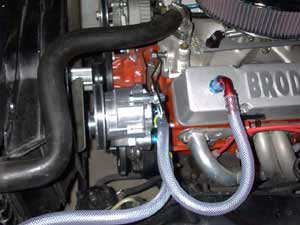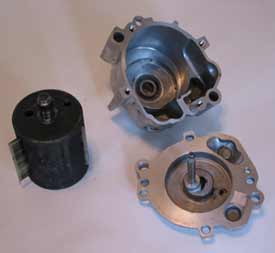 |
 |
PART 1 |
By Jay Storer
1/7/05 |
To some people the word “evacuate”
conjures up unpleasant images, but to drag racers who want
some free horsepower from their engine, the image is a win
light at the end of the 1320. We’re talking here about
taking away pressure from the engine’s crankcase and
making the job of the piston rings a lot easier. It’s
a simple, inexpensive addition to any sportsman or pro racecar
that benefits engine life, and the results can be worth one
to two tenths!
 |
| Up
to 30 extra horses from a re-engineered pump originally
designed for emissions purposes, who’d have thunk
it? GZ Motorsports did, and their complete crankcase vacuum
systems are now on many top Sportsman and Pro racecars. |
Back in the '70s, drag racers realized there was more to
releasing crankcase pressure than just having a pair of cool-looking
aluminum breathers bolted to their valve covers. Yes, breathers
kept undue pressure from accumulating in the crankcase and
valve covers, but someone figured out that sucking the fumes
out, rather than just letting them go, had more benefit by
allowing the piston to seal better.
This is when everyone started plumbing breather hoses down
to their header collectors and installing one-way valves.
The valves were those typically found in OEM smog-system piping
of the period and prevented exhaust pressure from going into
the crankcase, but allowed the negative pressure of the fast-moving
exhaust to deplete the pressure in the crankcase. It was worth
some power, kept the engine cleaner, and helped the rings
seal a little better.
Although the Pro Stock and a few other classes were using
some form of vacuum pump even then, the header-evac was the
state of crankcase evacuation for most racers until some years
later when mufflers were first required on some classes at
California tracks. For these cars, evacuation of the system
through the header collectors was no longer going to be an
option, since the draft in their system was virtually lost.
Greg Zucco, a structural engineer by profession and a dedicated
sportsman racer going way back, started his company GZ Motorsports
in 1985, making alternator mounting kits and supplying small
performance alternators for racecars after being frustrated
with ill-fitting kits he had purchased. Over the years, Zucco
had seen some vacuum pumps applied to drag engines to affect
a better suction on the crankcase to create more power, but
he again envisioned the possibility of something better than
what was generally available, as well as something more affordable
to the average racer.
 |
| Opened up for a forensic look
is the late-model Ford smog pump that is the basis of
Zucco’s racing evac system. The carbon-coated drum
(left) rotates inside the housing, and is equipped with
vanes for pumping air. The OEM precision-die-cast housings
are lighter than billet pumps. |
Around 1995 he began experimenting with automotive AIR (Air
Injection Reaction) pumps commonly called “smog”
pumps. These are designed to pump air into the exhaust system
with the goal of helping to finish off any tiny particles
of unburned hydrocarbons that escaped the combustion chambers.
Zucco bought rebuilt pumps designed for Toyotas because they
were cheap, uncomplicated and didn’t take up a lot of
space in the engine bay of his big-block-powered ‘34
Chevy Super Gas roadster. His engineer’s curiosity had
him dismantling various types of pumps to see how they worked
and how he could revamp them for drag racing.

|
